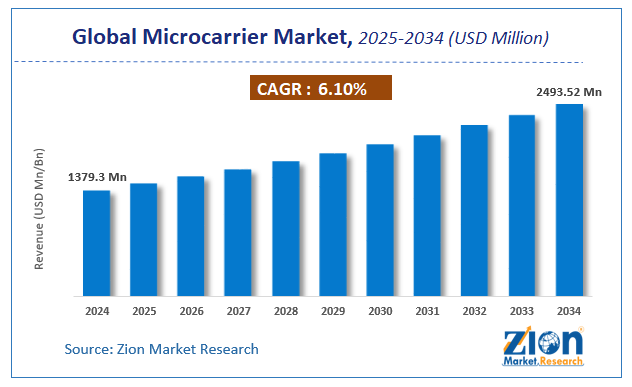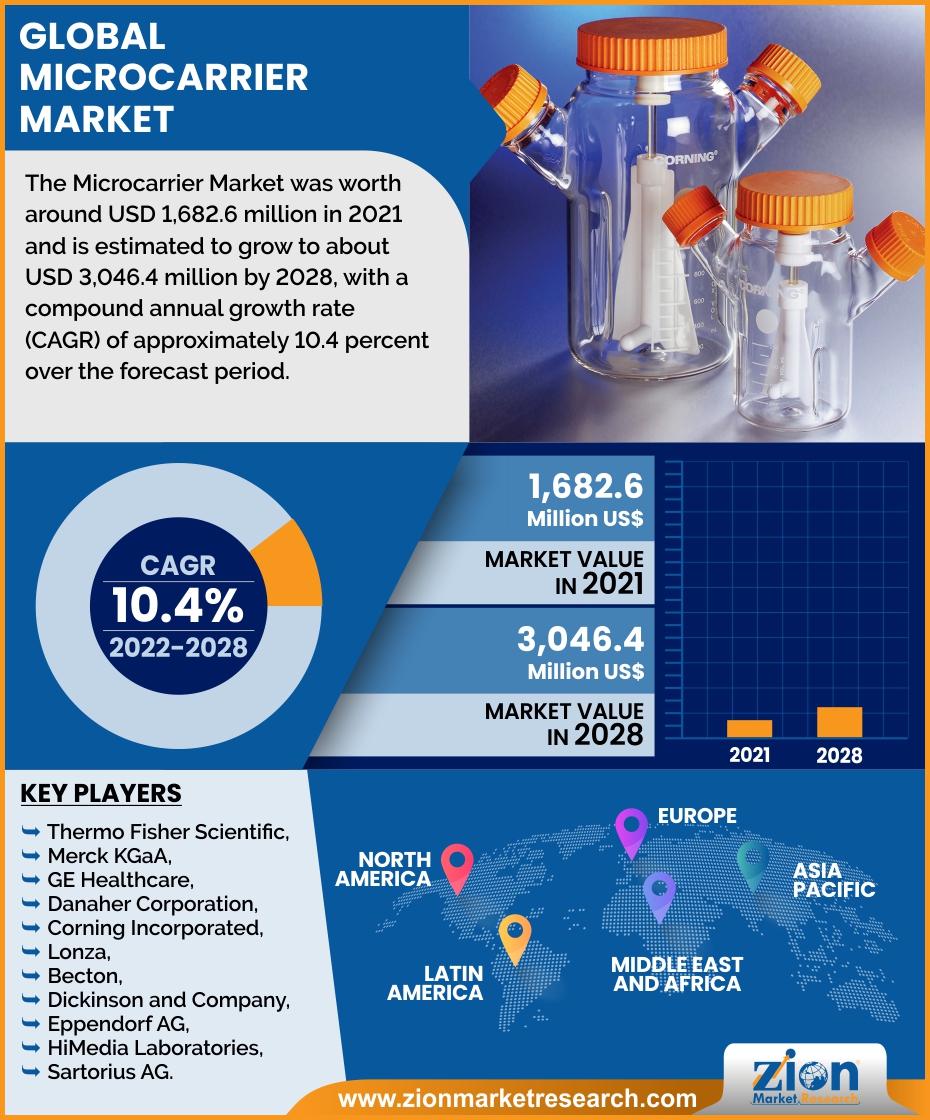Microcarrier Market Size, Share, Growth & Trends 2034

Microcarrier Market By Product (Equipment, and Consumables. By Application (Vaccine Manufacturing, Cell Therapy, and Others). By End User (Pharmaceutical and Biotechnology Companies, Research Institutes, and CROs), And By Region - Global And Regional Industry Overview, Market Intelligence, Comprehensive Analysis, Historical Data, And Forecasts 2025 - 2034
| Market Size in 2024 | Market Forecast in 2034 | CAGR (in %) | Base Year |
|---|---|---|---|
| USD 1379.3 Million | USD 2493.52 Million | 6.1% | 2024 |
Microcarrier Market: Size
The Microcarrier Market was worth around USD 1379.3 Million in 2024 and is estimated to grow to about USD 2493.52 Million by 2034, with a compound annual growth rate (CAGR) of roughly 6.1% between 2025 and 2034. The report analyzes the Microcarrier Market drivers, restraints/challenges, and the effect they have on the demands during the projection period. In addition, the report explores emerging opportunities in the Microcarrier Market.
Microcarrier Market: Overview
Cell culture techniques have become relatively important for the production of many vital biological products such as vaccines, antibodies, enzymes, hormones, and interferons. Microcarriers provide convenient surfaces for growing animal cells, increasing the yield of cells from culture vessels, and perfusion chambers. Several types of microcarriers are available in the microcarrier market, proving beneficial for efficient research and production of biological products. Microcarriers are very useful to grow adherent cell populations in the large-scale commercial production of biologics, biosimilars, and vaccines. Nowadays, biopharmaceutical production requires greater efficiency, fast technologies, low-cost methods, and more flexibility. Microcarriers provide ideal production of biological components, save time, reduce investment costs, and can be used in different production schemes.
Microcarriers help adherent cell development by acting as a support matrix. These microcarriers are placed in a bioreactor to aid in cell proliferation. The growing global disease burden has increased R&D activity with the goal of developing therapeutically effective drugs/vaccines, resulting in a need for microcarrier products. In addition, the growing requirement for therapeutically efficacious vaccines and pharmaceuticals is driving the worldwide microcarrier market, which has led to a growth in product demand for microcarriers. Many of the current biologics in development are aimed at indications that are dominated by small molecules and have a big patient pool. This implies that the biologics trend may infiltrate various non-traditional biologic disease areas during the projection period, benefiting from enhanced treatment efficacy.
Furthermore, this creates space for the Microcarriers market to expand. Governments throughout the world are expanding their funding in various types of healthcare research and encouraging corporations to expand their R&D activities in order to harness breakthrough technology in cell therapy.
Key Insights
- As per the analysis shared by our research analyst, the global microcarrier market is estimated to grow annually at a CAGR of around 6.1% over the forecast period (2025-2034).
- Regarding revenue, the global microcarrier market size was valued at around USD 1379.3 Million in 2024 and is projected to reach USD 2493.52 Million by 2034.
- The microcarrier market is projected to grow at a significant rate due to advancements in cell culture technology for regenerative medicine and biopharmaceuticals.
- Based on Product, the Equipment segment is expected to lead the global market.
- On the basis of Application, the Vaccine Manufacturing segment is growing at a high rate and will continue to dominate the global market.
- Based on the End User, the Pharmaceutical and Biotechnology Companies segment is projected to swipe the largest market share.
- Based on region, North America & Europe is predicted to dominate the global market during the forecast period.
Microcarrier Market: Driver
Increasing Interest in Cell-Based Vaccines and Therapeutics
The need for cell-based vaccines is increasing, technologies are improving, and financing from private and public enterprises for cell-based research is driving the market for Microcarriers. Due to their importance in the vaccine production process, cell cultures are also expanding. Due to its shorter lead time and capacity to generate vaccinations in bigger numbers as needed, cell-based vaccines have emerged as a considerably more efficient way than others. Cell-based vaccinations have been shown in clinical trials to be as effective, efficacious, and safe as previous cell-based vaccines. Manufacturers have been attempting to boost their capability to improve their vaccines by increasing production output, which aids in cost reduction. As a result, immunizations are now available all over the world.
Microcarrier Market: Restraint
The Expensiveness of Biologics and Cell-Based Therapies
Microcarriers as well as Cell cultures are very expensive and involve a lot of R&D on any new medicines that come out. Small-scale businesses and academic institutions have limited funds and cannot always afford research. Furthermore, microcarriers always adhere to the cells, and the cells must be retrieved by a costly downstream process. These are the most significant challenges confronting the microcarrier market, and they are impeding growth. Moreover, the high expense of cell biology research and the scarcity of low-cost serum-free media are two factors that are expected to stymie industry expansion.
Microcarrier Market: Segmentation
The Microcarrier Market is segregated based on Product, Application, and End User.
By Application, the market is classified into Vaccine Manufacturing, Cell Therapy, and Others. Over the forecast period, cell therapy is expected to show the most progress. Microcarriers aid in cost-effective cell production by lowering both fixed and variable costs during large-scale manufacture. The contemporary landscape has changed as a result of technical improvements, and the importance of microcarriers in cell treatment has grown. Since the microcarriers are totally dissolved, there is no need for separation, and the downstream process proceeds smoothly. As a result, these microcarriers are regarded as advantageous beads for large-scale cell manufacturing or cell treatment applications. Another element driving the expansion of cell therapy applications of microcarriers is that companies are now focusing on the provision of microcarriers that contribute to large-scale and cost-effective production.
By End User, the market is classified into Pharmaceutical and Biotechnology Companies, Research Institutes, and CROs. The pharmaceutical and biotechnology firms category is likely to dominate the microcarrier market. This is due to the increasing usage of single-use technologies in vaccine production and the expanding application areas of microcarriers. Due to the increasing demand for research and development in life-threatening diseases, the research institutes segment is expected to be the fastest expanding category. Microcarriers are used in a variety of research institutes to aid in patient health management. Demand for microcarriers is being created by innovation, discovery, and development in the microcarriers segment, which are assisting in making patient treatment more efficient.
Microcarrier Market: Report Scope
| Report Attributes | Report Details |
|---|---|
| Report Name | Microcarrier Market |
| Market Size in 2024 | USD 1379.3 Million |
| Market Forecast in 2034 | USD 2493.52 Million |
| Growth Rate | CAGR of 6.1% |
| Number of Pages | 169 |
| Key Companies Covered | Thermo Fisher Scientific, Merck KGaA, GE Healthcare, Danaher Corporation, Corning Incorporated, Lonza, Becton, Dickinson and Company, Eppendorf AG, HiMedia Laboratories, Sartorius AG.,, and others. |
| Segments Covered | By Product, By Application, By End User, and By Region |
| Regions Covered | North America, Europe, Asia Pacific (APAC), Latin America, The Middle East and Africa (MEA) |
| Base Year | 2024 |
| Historical Year | 2020 to 2023 |
| Forecast Year | 2025 - 2034 |
| Customization Scope | Avail customized purchase options to meet your exact research needs. Request For Customization |
Recent Developments
- In 2020, Thermo Fisher Scientific announced the development of a new cGMP plasmid DNA production plant in Carlsbad, California. The goal of establishing a new facility is to expand the commercial and clinical capabilities of cGMP plasmid DNA, which is commonly utilised as a raw material in the development of cell and gene therapies such as mRNA vaccinations and efficient cancer treatments.
Microcarrier Market: Regional Landscape
During the projection period, North America dominated the global market. The region's leadership is due to increased R&D investments in cell and gene therapies, as well as the acceleration of vaccine development and production in the midst of the epidemic. In addition, the technological developments in company R&D led to increased utilization of microcarrier products. In addition, the United States is experiencing tremendous growth in the biologics and biosimilar industries, which is one of the primary drivers driving the microcarrier market in this area.
Additionally, Asia Pacific is expected to have a higher growth rate throughout the projection period due to an increase in chronic disease incidence, which would lead to increased investments in research such as stem cells, cell biology, and so on. The availability of research funds, technologically improved goods, and the strategic expansion of biopharmaceutical enterprises in this region are all factors driving market growth in this region.
Microcarrier Market: Competitive Landscape
The report provides a company market share analysis to give a broader overview of the key market players. In addition, the report also covers key strategic developments of the market, including acquisitions & mergers, new product launches, agreements, partnerships, collaborations & joint ventures, research & development, and regional expansion of major participants involved in the microcarrier market on a global and regional basis.
Some of the main competitors dominating the Microcarrier Market include -
- Thermo Fisher Scientific
- Merck KGaA
- GE Healthcare
- Danaher Corporation
- Corning Incorporated
- Lonza
- Becton
- Dickinson and Company
- Eppendorf AG
- HiMedia Laboratories
- Sartorius AG.
Global Microcarrier Market is segmented as follows:
By Product
- Equipment
- Consumables
By Application
- Vaccine Manufacturing
- Cell Therapy
- Others
By End-User
- Pharmaceutical and Biotechnology Companies
- Research Institutes
- CROs
By Region
- North America
- The U.S.
- Canada
- Mexico
- Europe
- France
- The UK
- Spain
- Germany
- Italy
- Rest of Europe
- Asia Pacific
- China
- Japan
- India
- Australia
- South Korea
- Rest of Asia Pacific
- The Middle East & Africa
- Saudi Arabia
- UAE
- Egypt
- Kuwait
- South Africa
- Rest of the Middle East & Africa
- Latin America
- Brazil
- Argentina
- Rest of Latin America
Table Of Content
Methodology
FrequentlyAsked Questions
The global microcarrier market is expected to grow due to rising demand for cell-based therapies, stem cell research, and biopharmaceutical production for vaccine and protein synthesis.
According to a study, the global microcarrier market size was worth around USD 1379.3 Million in 2024 and is expected to reach USD 2493.52 Million by 2034.
The global microcarrier market is expected to grow at a CAGR of 6.1% during the forecast period.
North America & Europe is expected to dominate the microcarrier market over the forecast period.
Leading players in the global microcarrier market include Thermo Fisher Scientific, Merck KGaA, GE Healthcare, Danaher Corporation, Corning Incorporated, Lonza, Becton, Dickinson and Company, Eppendorf AG, HiMedia Laboratories, Sartorius AG.,, among others.
The report explores crucial aspects of the microcarrier market, including a detailed discussion of existing growth factors and restraints, while also examining future growth opportunities and challenges that impact the market.
RelatedNews
HappyClients
Zion Market Research
Tel: +1 (302) 444-0166
USA/Canada Toll Free No.+1 (855) 465-4651
3rd Floor,
Mrunal Paradise, Opp Maharaja Hotel,
Pimple Gurav, Pune 411061,
Maharashtra, India
Phone No +91 7768 006 007, +91 7768 006 008
US OFFICE NO +1 (302) 444-0166
US/CAN TOLL FREE +1 (855) 465-4651
Email: sales@zionmarketresearch.com
We have secured system to process your transaction.
Our support available to help you 24 hours a day, five days a week.
Monday - Friday: 9AM - 6PM
Saturday - Sunday: Closed







